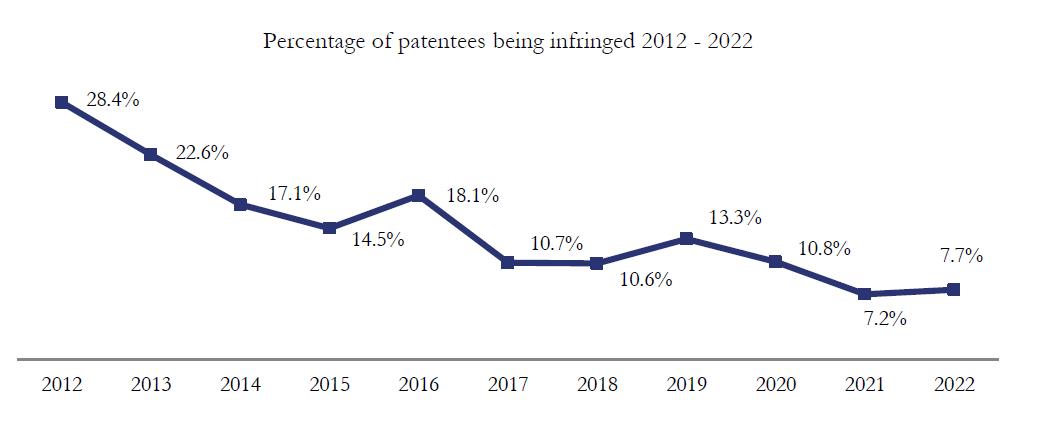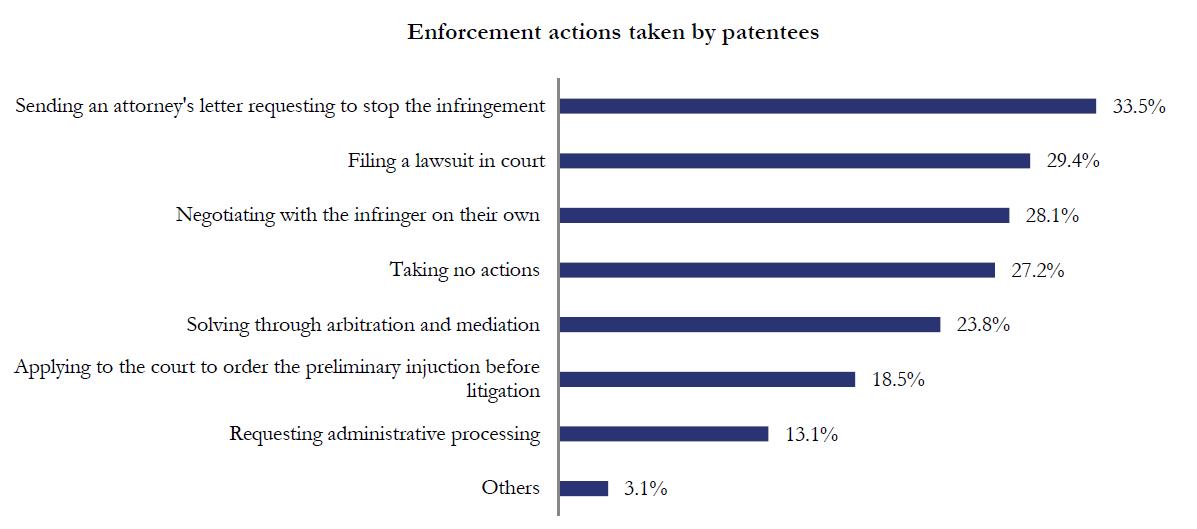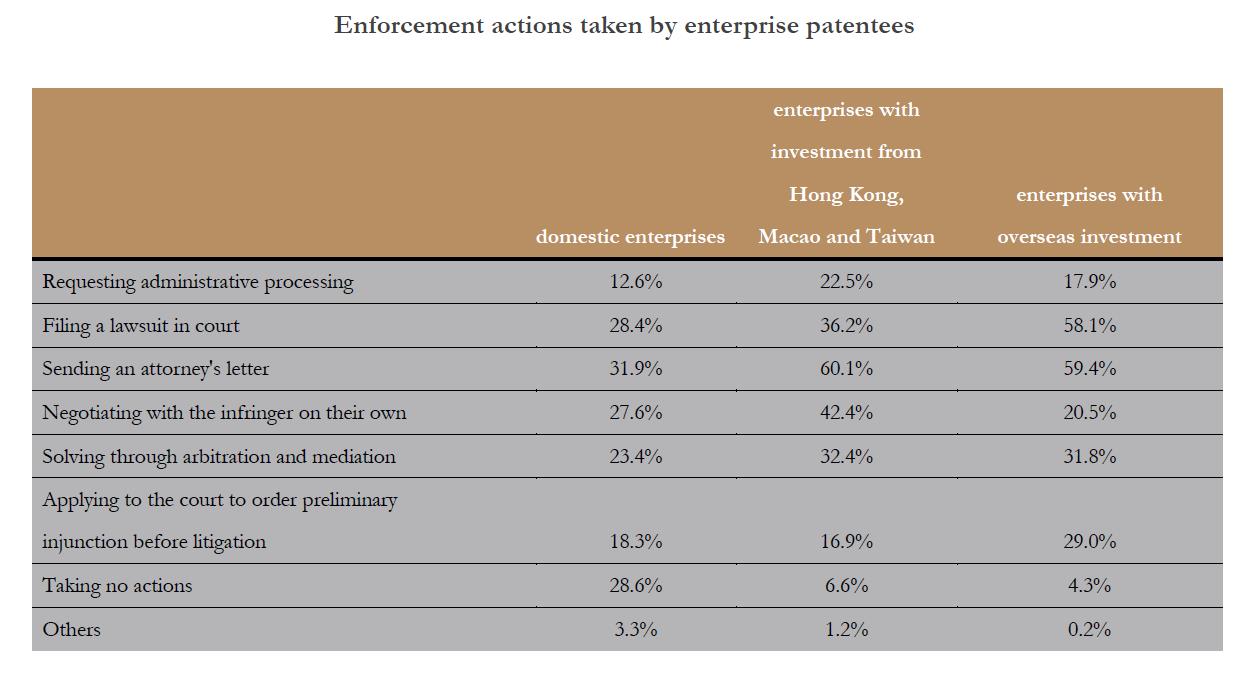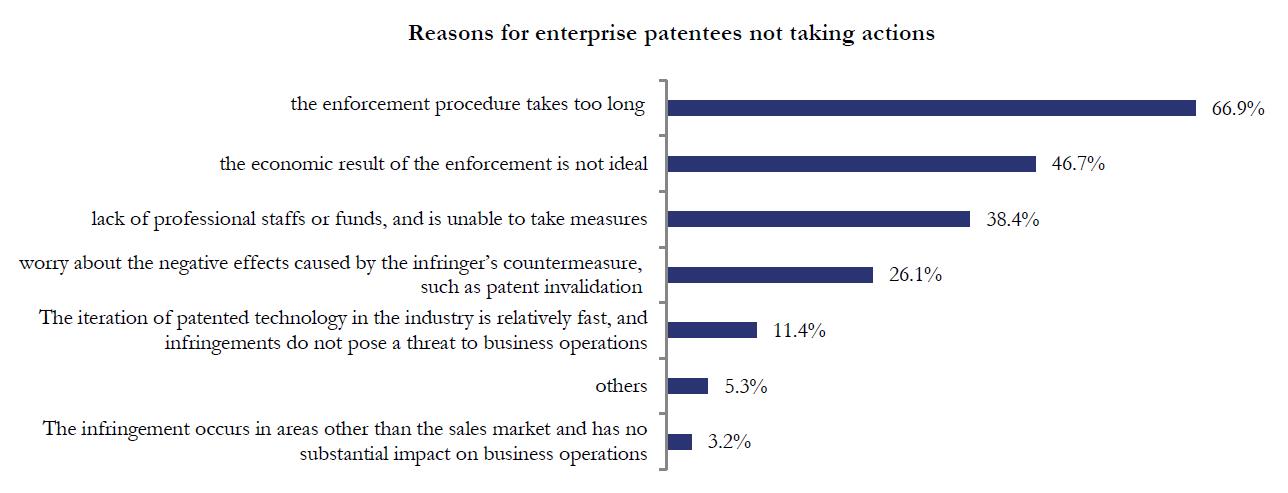Highlights from the Annual Patent Survey Report 2022
At the end of 2022, the China National Intellectual Property Administration (CNIPA) released its annual China Patent Survey Report. As you may know, since 2008, the CNIPA has sent relevant questionnaires to companies, universities and research institutions every year. The purpose of the survey is to analyze the development of patent creation, utilization and protection in China. Key aspects of the 2022 survey include not only the use, protection, and management of patents, but also the open license system, internationalization of intellectual property rights, and digital transformation. In this newsletter, we summarize the survey results related to patent infringement.
Percentage of Being Infringed
According to the survey, 7.7% of patentees believed that their patents were infringed in 2022. Ten years ago in 2012, the corresponding percentage was 28.4%. In general, the percentage of patentees who have experienced patent infringement in China showed a tendency to fall during the past ten years.

However, it seems that companies with investment from Hong Kong, Macao and Taiwan, and from overseas are more likely to experience infringement than domestic-funded enterprises. 12.4% companies with investment from Hong Kong, Macao and Taiwan and 10.4% companies with overseas funding have experienced infringement in 2022, while the percentage of domestic companies was 7.5%. Also, as the report shows, the larger the company, the higher the percentage. Overall, 10.3% of larger enterprises reported being infringed.
Enforcement Actions
The survey shows that the percentage of companies which took actions to enforce their rights has increased to 72.2%. Still, more than 1/5 of companies chose not to take any action, even though they believed that their patents were being infringed.
50.2% of enterprise patentees took two or more actions to protect their rights. Sending an attorney's letter; filing a lawsuit and negotiating with the infringer were the most popular actions. Comparing to 2021, the percentage of companies choosing arbitration and mediation, and applying for preliminary injunction has increased by more than 5%.

We also notice that domestic and foreign invested companies took different approaches in this regard. The domestic companies mostly chose to send an attorney's letter to the infringer, to file a lawsuit or to negotiate with the infringer on their own. Interestingly, 28.6% the domestic companies decided also not to take any action.
For enterprises with investment from Hong Kong, Macao and Taiwan, sending an attorney's letter was the most popular measurement. More than 40% of these companies also tried to negotiate with the infringer on their own.
Overseas-funded companies, however, tended to take legal actions, such as sending an attorney's letter and filing a lawsuit. Trying to negotiate with the infringer on their own was not a very popular measurement among those companies.
In general, only a small percentage of companies with investment from outside mainland China chose to take no actions, in contrast to domestic companies.

Reasons for Not Taking Actions
According to the survey, the main reasons that the enterprises did not take any action after being infringed were "the enforcement procedure takes too long" (66.9%) and "the economic result of the enforcement is not ideal" (46.7%). Also, the lack of professional resources and worrying about the negative effects caused by the infringer's countermeasures, such as patent invalidation, prevented the enterprises to take any action.

The survey shows that the lack of resources (38.4%) and the worry about the countermeasures (26.1%) seemed to particularly cause concerns for domestic enterprises.
According to the 2022 survey, more than 50% of the patentees indicated that it was "difficult" or "very difficult" to prove that the infringement was intentional, to determine the illegal gains by the infringer, or the actual losses suffered by the patentee, due to the infringement, to prove that the other party has infringed, or to determine the seriousness of the infringement.
Financial Compensation
The survey shows that the percentage of higher amounts of compensation in patent infringement cases has increased in recent years. In 2022, 7.0% of patent infringement litigation have a damage award of more than 5 million RMB. In 2016, this percentage was only 0.1%. Nevertheless, the percentage of "No compensation" and compensation less than 500 thousand RMB is still high.

We note that the latest amendment of the Chinese Patent Law (in effect since 1st of June 2021) introduced several changes regarding patent infringement, such as increasing the statutory damages ceiling to 5 million RMB; and introducing punitive damages of up to 5 times the determined damage in case of willful infringements with serious circumstances. Also, the amendment shifted the burden of proving damages in certain situations, which makes it easier for the patentee to prove the damage amount. These changes will encourage patentees to take more actions to protect their rights.
If you have any questions, please contact us at sinda@chinasinda.com.






